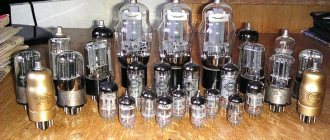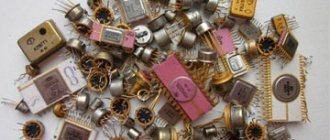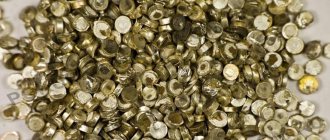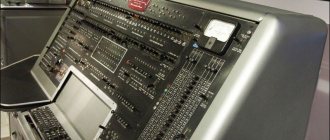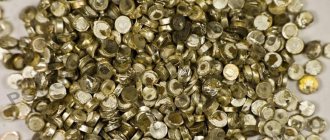Craftsmen have long learned to extract silver and gold from radio components in artisanal conditions. Outdated tube televisions, radios, tape recorders and other electrical equipment of the last century are a source of treasures. They find silver, platinum, tantalum, gold in radio tubes, and there are precious metals in the TV picture tube. During the Soviet era, they were not saved for the national economy. There was no complete replacement for silver and gold in those years.
Precious metals continue to be used. Office equipment and computers are subject to Article 19.14 of the Administrative Code (Administrative Code of the Russian Federation) on the circulation of precious metals. In radio engineering, high-purity alloys with a minimum of impurities are used. Some companies earn good money from recycling household and industrial equipment - they engage in recycling. The technology for extracting silver and gold is simple and can be done by a high school student.
Why is gold used in devices?
Experts advise looking for precious metals in microcircuits, connectors, semiconductors, and other radio components.
At the dawn of radio electronics, corrosion-resistant conductive circuits and plates could be made from precious metals. Gold and other precious metals are still used to make SIM cards and microcircuits, but the details have become much finer. Based on the gold content in radio components, professionals determine the age of equipment. The high content of precious metals in radio tubes means that it was applied to the grid in the cathode region to correct electrons.
Gold is used where corrosion is excluded and sparking must be prevented. When externally disassembled, precious metals can be difficult to notice; they are used in the form of:
- microscopic parts or elements;
- foil several microns thick;
- coatings made by spraying or galvanic method.
Most of the precious metals are in old Soviet-style parts. According to statistics, more than 80% of silver used in industry is consumed by the electrical engineering industry for electrical and radio equipment.
Used picture tubes are a source of secondary resources. The high content of precious metals in cathode ray tubes is explained by the complexity of the design: electron gun, control system. It is difficult to recycle them; old TVs gather dust in dachas and garages, although they can become a source of income.
How to determine authenticity
The composition of a part or coating is determined by GOSTs. But there are no such concepts as “genuine” and “fake” technical silver - for two reasons:
- For each purpose, a different alloy is selected. Impurities in it change the properties of the base, and “purer” does not always mean “better” here.
- It is not economically feasible to counterfeit the precious metal used in microcircuits and switches.
If you accidentally come across a homemade “technical” ingot and are wondering if it is silver, try using a magnet on it (a high-grade alloy will not be attracted) or rubbing it in your hand with chalk (the chalk should darken).
Radio components containing precious metals
Gold and silver are mainly found in domestic radio components, much less in imported ones. There are rare precious metals in the kinescope. For example, platinum. Many parts are made from alloys with a high content of valuable components. Gold coatings can be recognized by color; other precious metals are more difficult. Palladium content in radio components is up to 80%. Radio engineering scrap of military equipment and oscilloscopes are valued. Gold is often hidden under the case, silver can be found on the switch contacts.
Radio tubes
Valuable metals in radio tubes are extracted by dissolving sputtering and gilding. In some models of televisions and radio equipment, the gold content in radio tubes reaches 9 grams (GI-42B P3), the minimum in grade 12P17L.
Microcircuits
Gold is an inert conductive metal. They do soldering and cover contacts. High Au content in m/s K1108PA15, 1109KT5. On modern samples, gold is replaced with high-grade alloys. Craftsmen put the extraction of silver from radio components of this kind on stream.
Transistors
There is more gold in transistors from defense plants than in other manufacturers, especially in the KT series, up to 200 mg. There are palladium and platinum. The yield of precious metals depends on skillful sorting of scrap and dismantling of transistors.
Relays and connectors
For the chemical extraction of silver from radio components of electrical installations, relays of the RVM and RES series are selected. Recycling of connectors is carried out by melting scrap precious metals.
Resistors
Precious metals are sought in parts produced before the 80s of the last century. Productive are the PP and K series with a diamond image. Modern resistors are made from other materials. Accurate information is available in reference tables posted in the public domain.
Capacitors
Silver is found in the K10, K15 series, products from the last century with a yellow body. They were used in tube radio equipment and televisions with kinescopes. Palladium and platinum are contained in open-frame capacitors.
Where is it contained?
Technical alloys are used to create much of what we use every day. If you are reading this article at work, look around and look at the office equipment - there is silver in every device and microcircuit. One power supply contains 1.5 g.
The more modern the device, the less precious metals it contains and, accordingly, the more difficult it is to extract them.
The state controls the disposal of equipment not only for reasons of environmental safety, but also to reduce the loss of precious metals during processing. Only licensed organizations can accept high-tech scrap containing precious metals from the population—for example, there are several dozen of these in Moscow.
Methods for extracting gold from radio components
The gold content in radio components rarely coincides with the declared one. Gold plating is common in case parts and connectors. Gold from radio tubes is valued for its high purity. The precious metal is mined in two ways: chemical and smelting.
Pieces of scrap, parts containing gold plated or gold alloys are dissolved in “aqua regia”, this is a mixture of two acids: nitric and sulfuric in a ratio of 1:3, dissolves many precious metals. To speed up the process, the flask is heated to 80°C. Load the metal in portions and make the mixture saturated. Copper causes the liquid to turn dark green. Gold is precipitated with table salt at the rate of 2 g per 100 ml of gold-containing liquid. Then the excess liquid is evaporated. The scaly sediment is dried.
Smelting begins with the refining of precious metals - deep cleaning of the charge is carried out:
- Contaminants are removed by washing;
- magnet - pieces of low-alloy steel with gold plated.
The resulting precipitate is melted until the gold is completely reduced under a borate or borax flux. The powder reduces the melting point of scrap. Melting point is about 1000°C.
Methods for extracting silver from radio components
Silver-containing alloys, from which connectors and contacts are made, are used as raw materials. To extract silver from radio components, metals are dissolved. Before processing, devices and radio components are disassembled. Remove plastic, polymers, semiconductors, and copper-containing parts.
The production of silver comes down to carrying out a qualitative reaction to Ag+ ions in a solution of nitric acid. The prepared raw materials are poured with HNO3 to dissolve the silver. AgNO3 is then precipitated with zinc dust or the introduction of hydrochloric acid.
Silver chloride (AgCl) precipitates in the form of flakes, it is filtered and dried. It is then melted down into an ingot. You can heat the flakes in a tin can or ceramic crucible on a gas stove, blowtorch, using a gas cutter or a universal burner.
When melting silver chloride and scrap, borax is used as a protective flux. It forms a layer of slag cap on the melt, silver is less oxidized. The melt is poured onto a metal plate or into sand. The finished casting is washed.
Where can you buy or sell
There are organizations involved in purchasing, including technical silver, online auctions, and pawnshops. Most of them operate illegally (without a license), and an attempt to sell independently mined silver may come to the attention of the Department for Combating Economic Crimes (OBEP).
How much does 1 gram of tech cost? silver for today
The value of silver on the world market is rising and today it is considered a good investment. A chart will help you track price fluctuations.
Extracting precious metals from radio components at home
The technology for producing silver from radio components depends on the condition of the metal. A layer of contact or housing coating of several microns is dissolved, like gold plating, in acid. You can extract silver in the form of scrap:
- from relay contacts, there is a lot of it in radio components of the USSR era;
- fuse links;
- capacitors.
Scrap is smelted into ingots using an artisanal method; the metal melts at a temperature of 960°C. The crucible is filled to 1/3 of the volume, the slag is removed with a long spoon or a wire loop.
Homemade methods of removing gold plating from brass or copper surfaces have been known for a long time. The electrolysis method is used: current is passed through the solution, and pure metal is deposited on one of the conductive plates. Gold-containing components are “mined” in two ways: electrolysis and hot dissolution.
Nitric acid treatment
Radio components containing silver and other noble metals are immersed in a thermal flask and filled with an acid solution. Palladium, gold, platinum are precipitated without dissolution, silver forms nitrate AgNO3. It must be converted to insoluble chloride. A salt solution is added to the flask. Chloride is formed, which at temperature decomposes into chlorine (it evaporates) and pure silver.
Silver alloys dissolve well in 30% acid heated to 60°C. There is no need to throw in all the scrap at once; it’s easier to introduce the metal in portions of 3–5 grams. The solution should be transparent without inclusions. If it was not possible to remove all the plastic, the mixture should be filtered and interfering inclusions removed before sedimentation.
Heat treatment
The hot method of gold extraction involves the preparation of “aqua regia” (a mixture of concentrated sulfuric and nitric acid). It is heated to 70°C. It is enough to immerse the radio components for a few minutes.
Silver is extracted by anodic electrolysis in warm acid (heated to 35°C). When the entire silver layer dissolves, the metal settles on the cathode, and the current strength decreases. A lead or iron strip is used as a cathode. The current density varies from 0.1 to 1 A/dm2. Installation is easy.
The reagents necessary for the extraction of precious metals are purchased in specialized stores. Platinum is extracted using the same technology.
Application of technical silver and its alloys
Due to its physical and chemical properties: thermal conductivity, electrical conductivity, ideal reflectivity, low chemical activity, excellent resistance to corrosion processes, parts are coated with pure technical silver to make them more resistant to corrosion. This metal is used to produce contacts with low contact resistance, electrical conductors, some products for the chemical industry, and it is added to photosensitive materials.
Often, in order to improve the performance of a device or equipment, alloyed technical silver is used in the manufacture of parts. The metal has widespread use in the manufacture of alloys, such as silver-containing solder alloys. Thus, various radio components and electronic components, electrical discontinuous and sliding contacts are produced from an alloy of silver and copper. This alloy has high hardness and wear resistance, but at the same time, with a large amount of copper in the alloy, the resistance to oxidation and corrosion decreases. Alloys of silver and palladium and silver/platinum have significant, compared to pure silver, resistance to atmospheric corrosion, sulfur compounds, and have high hardness.
The largest volume of technical silver is contained in old Soviet equipment; of course, this metal is also present in modern parts, but in small quantities and not as pure as in Soviet parts. In the USSR, all devices containing precious metals were strictly registered; after decommissioning, the metals were confiscated and handed over to a special commission. Today, anyone who owns these devices and equipment can seize silver-containing RECs and sell them.
Silver contains:
- Wire, plates, contacts, microcircuits, relays
- Housings, frames
- Switches, connectors
- X-rays, photographic films
- Batteries
- Aviation wires, etc.
